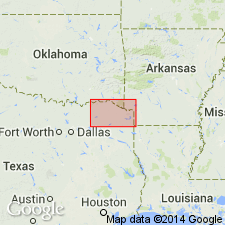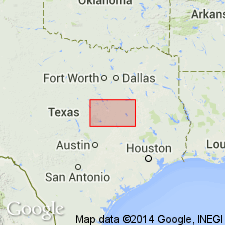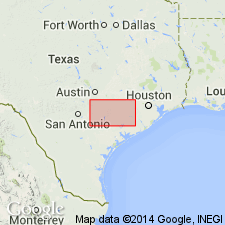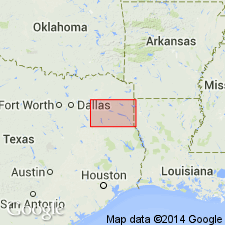
- Usage in publication:
-
- Sparta Sand
- Modifications:
-
- Mapped 1:250k
- Dominant lithology:
-
- Sand
- AAPG geologic province:
-
- Arkla basin
- East Texas basin
Summary:
Sparta Sand. Quartz sand, fine to medium grained, silty, argillaceous, weakly coherent, locally carbonaceous, massive, locally cross-bedded, interbeds of sandy clay more abundant upward, light-gray to brownish-gray; weathers light-gray and various shades of red, at base hard, brown, ferruginous sandstone; lower 50+ feet present. Lies above Weches Formation and below unnamed Pleistocene fluviatile terrace deposits. Age is Eocene.
[Mapped along southeastern edge of map sheet, in Morris and Cass Cos., northeastern TX, and Miller Co., southwestern AR.]
Source: Publication.

- Usage in publication:
-
- Sparta Sand
- Modifications:
-
- Mapped 1:250k
- Dominant lithology:
-
- Sand
- AAPG geologic province:
-
- East Texas basin
Summary:
Sparta Sand. Quartz sand, very fine- to fine-grained, silty clay partings, locally carbonaceous, laminated, very pale orange to grayish brown, weathers yellowish brown to reddish brown. Thicknes about 200 feet. Lies above Weches Formation and below Stone City Formation. Age is Eocene.
Mapped in Robertson and Leon Cos., eastern TX.
Source: Publication.

- Usage in publication:
-
- Sparta Sand
- Modifications:
-
- Mapped 1:250k
- Dominant lithology:
-
- Sand
- AAPG geologic province:
-
- Gulf Coast basin
Summary:
Sparta Sand. Quartz sand, very fine- to fine-grained, well sorted, micaceous, lignite beds near top, moderately indurated near base, friable toward top, some silty clay partings, light gray to very pale orange to grayish brown; weathers yellowish brown to reddish brown. Thickness about 130 to 150 feet. Overlies Weches Formation (Eocene); underlies Cook Mountain Formation (Eocene). Age is Eocene.
Mapped in Wilson, Gonzales, Fayette and Bastrop Cos., southeastern TX.
Source: Modified from GNU records (USGS DDS-6; Denver GNULEX).

- Usage in publication:
-
- Sparta Sand
- Modifications:
-
- Mapped 1:250k
- Dominant lithology:
-
- Sand
- Clay
- Sandstone
- Greensand
- AAPG geologic province:
-
- East Texas basin
- Arkla basin
Summary:
Sparta Sand. Quartz sand, fine- to medium-grained, light gray to brownish gray, slightly cohesive from silt and clay matrix, massive, locally cross-bedded, interbeds of sandy clay more abundant upward, locally carbonaceous; weathers various shades of light gray, at base hard, brown, ferruginous sandstone; lower part 170+/- feet thick, upper part absent. Locally includes Tyler Greensand Member (separately mapped). Occurs above Weches Formation. Age is Eocene.
[Mapped in Anderson, Camp, Cass, Cherokee, Harrison, Henderson, Marion, Morris, Smith, Upshur, Van Zandt, and Wood Cos., eastern TX.]
Source: Publication.

- Usage in publication:
-
- Sparta Sand
- Modifications:
-
- Mapped 1:250k
- Dominant lithology:
-
- Sandstone
- Siltstone
- Clay
- AAPG geologic province:
-
- Gulf Coast basin
Summary:
Sparta Sand. Sandstone; quartz sand, very fine- to fine-grained, well sorted, micaceous, some silty clay partings and interbedded siltstone, light gray to very pale orange to grayish brown; weathers yellowish brown to reddish brown. Thickness about 150 to 250 feet. [Correlative with lower part of Laredo Formation mapped southwest of Frio River.] Lies above Weches Formation and below Cook Mountain Formation. Age is Eocene.
[Mapped northeast of Frio River, in Frio and Atascosa Cos., southern TX.]
Source: Publication.

- Usage in publication:
-
- Sparta Sand
- Modifications:
-
- Mapped 1:250k
- Dominant lithology:
-
- Sand
- AAPG geologic province:
-
- Gulf Coast basin
Summary:
Pamphlet [p. 2]. Sparta Sand. Quartz sand, very fine- to fine-grained, well sorted, micaceous, some silty clay partings and interbedded siltstone, light gray to pale orange to grayish brown; weathers yellowish brown to reddish brown; thickness about 130 feet. Overlies Weches Formation; underlies Cook Mountain Formation. Age is Eocene.
[Mapped in southeastern corner of map sheet, in Wilson and Atascosa Cos., southern TX.]
Source: Publication.
For more information, please contact Nancy Stamm, Geologic Names Committee Secretary.
Asterisk (*) indicates published by U.S. Geological Survey authors.
"No current usage" (†) implies that a name has been abandoned or has fallen into disuse. Former usage and, if known, replacement name given in parentheses ( ).
Slash (/) indicates name conflicts with nomenclatural guidelines (CSN, 1933; ACSN, 1961, 1970; NACSN, 1983, 2005, 2021). May be explained within brackets ([ ]).

